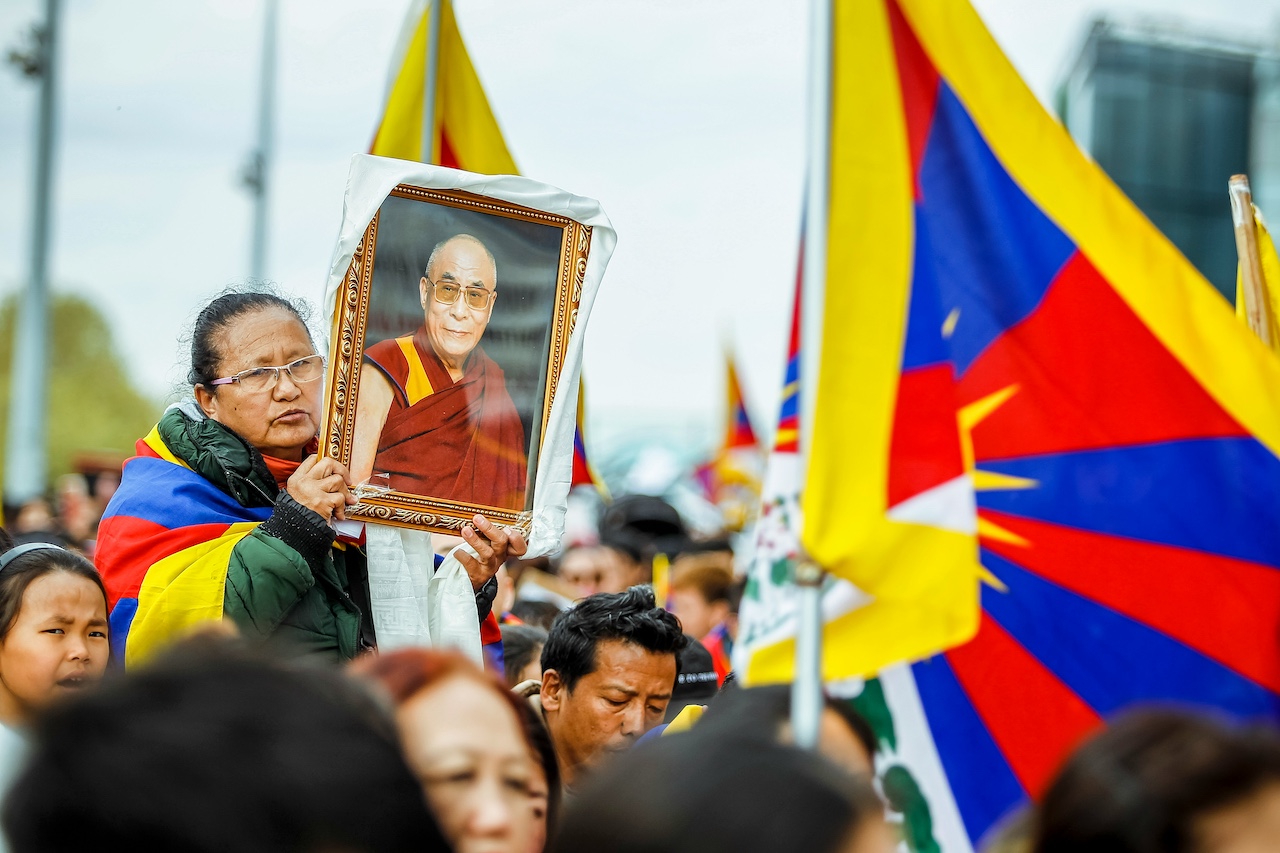Practices I Find Helpful in the Face of Suffering
His Holiness provides practical advice for overcoming despair and hatred when faced with adversity. The post Practices I Find Helpful in the Face of Suffering appeared first on Tricycle: The Buddhist Review.

It is human to feel discouraged when confronted with terrible suffering with no perceivable end in sight. This is the experience for those in Tibet, and for so many who have aspired for freedom under oppressive regimes. This must have been the overwhelming feeling for those many thousands of students in Beijing in 1989, in the wake of the cruel crackdown. Many a time, in the years since 1950, I too have been confronted with such feelings and have had to sustain my sense of hope.
Here are some practices I have found helpful in my own life. First and foremost, I remind myself that in any important journey we will face difficulties, so it is crucial to adopt a stance of being prepared right from the start. This way, when we meet adversities, they do not come as a shock out of the blue and catch us unaware. As a Tibetan saying goes, “Hope for the best, and prepare for the worst.”
Suffering and problems are an inevitable part of human life; the question is how we respond. When we face suffering caused by natural disasters, despite the devastation and the loss of human life, generally, we are able to cope with the pain without giving in to defeatism or bitterness. These tragedies also bring out the best in humanity, and people respond spontaneously with compassion. There is, however, man-made suffering, for which we humans ourselves are the direct cause. It is this class of suffering that is harder to bear and requires more strength on our part to deal with. There is the risk of giving in to despair and hatred, or responding to violence with violence. Unfortunately, we humans tend to keep repeating this cycle. The key here is never to lose sight of our shared humanity, common to perpetrator, victim, and ourselves. It is exactly for this reason I have always urged my fellow Tibetans to guard against hatred toward the Chinese.
I once told my fellow Tibetans when marking the first anniversary of the uprising in 1959 that in spite of the fact that we have to oppose Communist China’s actions, I can never bring myself to hate its people. I said that, especially from the perspective of our struggle for freedom, hatred of an entire people will be a weakness, not a strength. I also reminded them that when the Buddha spoke of hatred leading only to further hatred, he was not just giving a spiritual teaching; he was also giving practical advice. I truly believe that a movement rooted in hatred, however noble the cause, will destroy the basis for a lasting future resolution. In Buddhist teachings there is, in fact, a special emphasis on viewing one’s adversaries—those who are creating trouble for you—as spiritual teachers. Regardless of their intention, they provide you with the opportunity to practice patience and compassion. Our adversaries are our most valuable teachers. This is a demonstrable fact of life. While our friends can help us in many ways, it is our adversaries who provide us the challenge to develop the virtues essential for cultivating peace of mind and bringing us true happiness.
Personally speaking, as a follower of Mahayana (a system of Buddhism that I personally refer to as the Sanskrit tradition, which we Tibetan Buddhists share with Chinese Buddhism), I have a deep appreciation for the ancient nation of China in preserving the Buddhist tradition. Buddhism came to China about four centuries before it arrived in Tibet. Many texts that are lost in their original Indian language today survive in Chinese translation, such as the famous fifth-century Buddhist logician Dignāga’s work, Hetumukha. Within the two Tibetan canonical collections of Kangyur (translation of scriptures) and Tengyur (translation of treatises), there are several important texts translated from Chinese. The Chinese commentary on the famed Mahayana scripture Samdhinirmocana Sutra (Unraveling the Intent) by the Korean monk Woncheuk is highly admired in the Tibetan monasteries. Numerous schools of Mahayana Buddhism emerged, developed, and flourished in China—for example, Tiantai, Huayen, San-lun, Pure Land, and Chan. Admirably, it is only in the Chinese tradition that the lineage of full ordination for women as bhikshuni (fully ordained nuns) has survived, traceable all the way back to the time of the Buddha. The continued existence of this women’s full ordination tradition gives me great joy. Among the numerous Chinese monastics I have met over the years—in Taiwan and in the West—two who inspired me most in the richness of the Chinese Buddhist tradition were the revered Chan master Sheng Yen and the great Chinese Vinaya master Dao-hai. I have had the opportunity to engage in formal dialogues with both, on our two Buddhist traditions—Tibetan and Chinese—with the latter once also in New York. I even had the aspiration to visit the sacred Buddhist site of Mount Wutai Shan with master Dao-hai so that we could conduct a reading in Chinese, Tibetan, and Sanskrit of Nagarjuna’s famed Treatise on the Middle Way, which is dear to both Tibetan and Chinese Buddhism.
Regardless of whatever happens, we must never lose faith in humanity.
Needless to say, the courage and spirit of the indefatigable Chinese pilgrims who traveled to India in search of Buddhist texts and practice traditions has been a profound and continuing inspiration for me. From Faxian at the end of the fourth century to Xuanzang in the mid-seventh century, and Yijing in the later seventh century, these extraordinary monks risked everything for the sake of the dharma. One remarkable thing about these Chinese monks is the meticulous records they kept of their journeys. Of these pilgrims, Xuanzang’s enduring contribution is universally recognized today. His story is the inspiration behind the famous fable of Monkey in the Chinese literary tradition. It was thanks largely to Xuanzang’s Records of the Western Regions—a massive account of his travels formally prepared for the Tang emperor on his return—that many of the important sites associated with the life of the Buddha and with the history of Buddhism in India, such as Nalanda University, were later rediscovered. Today, millions of Buddhists from all over the world are able to make pilgrimages and honor these sites. So I have always been someone with a deep reverence and respect for the ancient nation of China and its people.
Second, I find it helpful to adopt a wider perspective, since our sense of being overwhelmed or powerless often arises from viewing a problem too closely. If you look at your palm up close, you can’t see your hand properly. By looking too closely, we get fixated and our perspectives narrow. In contrast, if we can situate the given problem in a larger context, we are then able to appreciate its complexity—its causes, effects, and interconnections—allowing us to choose a course of action that is more in tune with reality and has greater likelihood of success. The wider perspective also allows us to see any issue within its right proportions, making what previously seemed insurmountable possible to manage, and to recognize any positive aspects there might be despite what has happened. The embracing of this kind of wider perspective also makes it possible for us to see the opportunities a specific adversity might bring. As I have often stated, becoming a stateless person brought me closer to reality. When you are a refugee, there is no room left for ceremony or pretension. Had I remained in Lhasa as the theocratic ruler of an independent Tibet, imprisoned in what might be called a “golden cage” as the holy Dalai Lama, today I might be quite a different person. Being outside my homeland as a refugee has allowed me to meet with people from so many diverse backgrounds and walks of life—from fellow spiritual seekers to scientists, from activists to political leaders, and from artists to engineers. I particularly cherish the privilege I have had to establish friendships and engage in deep conversations with scientists. I would argue that my own Tibetan Buddhist tradition too has gained a lot from my being in exile. Today, we have successfully instituted the Geshema degree (highest monastic academic accomplishment) for the nuns; introduced formal science education in the monasteries; and initiated ongoing dialogues and collaborations with scientists on the study of the mind and possible applications of mind-based tools for greater mental well-being. The point is that if, instead of adopting a wider perspective, we had chosen to remain fixated on our loss, we would have never had the will or inclination to explore the opportunities that opened up in the wake of our tragedy.
Third, it is essential to choose optimism as a basic standpoint, however bad things may seem. The problem with its opposite, pessimism, is that one has already chosen to give up, even before trying. Of course, optimism must be based on an appreciation of reality and a clear-eyed approach to seeking the best way forward. In the case of Tibet, for example, the issue is existential and we don’t have the luxury of giving up. That is what pessimism is.
Fourth, it is important to recognize and appreciate past successes, no matter how small. This is vital for encouraging ourselves and recharging our motivation to keep on going. We must never lose hope and must always maintain it if we are to meet with success in the challenges we face. With hope, we have the courage to care and the courage to act.
Finally, regardless of whatever happens, we must never lose faith in humanity. Here the key is to remain in touch with our own natural capacity to care for others, and never become divorced from our shared humanity, even in relation to those who might have done us harm. Personally, I find this basic altruistic orientation of the heart to be the source of my greatest strength and courage. Every morning when I get up, I remind myself I am just another human being, one among the billions on this earth. We are all the same, each and every one of us wishing to be happy and not wanting suffering. As social beings, we seek connection with others and find joy through them. There is no such thing as my own independent interest separate from others’, because our well-being is interconnected with the well-being of others. With this in mind, I chant these verses from the eighth-century master Shantideva:
All those who are happy in the world
Are so because they desire happiness for others;
All those unhappy in the world
Are so because they desire only their own happiness.
Therefore, if one does not switch the outlook
Of self-centeredness to other-centeredness,
Let alone the attainment of enlightenment,
Even in this life there can be no joy.
As long as space endures,
As long as sentient beings remain,
Until then, may I too remain,
And dispel the miseries of the world.
Chanting these verses gives me deep inspiration and reinforces my determination on a daily basis.
We are all the same human beings sharing this small planet. We all happen to have been born here at this time in the long history of humankind. At most, we have a life span of about a hundred years. This is but a blip in the great age of our planet. What matters most is what we do with our short life. If we live our life divorced from our shared humanity, embroiled in discord and division, and causing harm, what a waste of our precious life! If we choose to live our life caring for others—our human family and fragile planet—we will have made our life meaningful. So, when the final day comes, we will look back without regret and feel that our life on this earth has been worthwhile.
♦
From Voice for the Voiceless: Over Seven Decades of Struggle with China for My Land and My People by the Dalai Lama. © 2025 by the Dalai Lama. Reprinted by permission of HarperCollins Publishers.

 Hollif
Hollif 
































